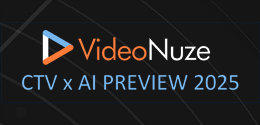-
CMAF: What It Is and Why It May Change Your OTT Future
Thursday, June 23, 2016, 10:06 AM ETPosted by:Apple made an important announcement at its recent Worldwide Developers Conference that marks a significant step toward simplifying online video delivery thereby reducing the cost of content preparation. By announcing support for fragmented MP4 (fMP4) within HTTP Live Streaming (HLS), Apple is bringing the industry closer to the realization of a single format for OTT medial delivery. This could save the OTT industry millions in revenue lost from processing their content across the plethora of formats that exist today.
Categories: Technology
Topics: Apple
-
Connected TV: Why Is It So Important - And to Whom?
Tuesday, June 7, 2016, 8:37 AM ETPosted by:In today’s on-demand culture, the days of passive television viewing are over. People prefer to choose the exact content they want to watch when they want to watch it. It’s no longer about who controls the TV remote – it’s now about controlling our individualized viewing experience and schedule.
It’s no surprise, then, that more than half of all U.S. homes own a Connected TV (CTV), a set that plays traditional TV programming yet is also connected to the Internet through a stand-alone streaming device. These devices, such as Roku, Apple TV, Amazon Fire, Chromecast, etc., enable access to over-the-top (OTT) services like Netflix, Hulu and Amazon, to name but a few, as well as ad serving and digital measurement.Categories: Advertising, Devices
Topics: Brightcom
-
Can Software Help Value Premium Digital Content?
Wednesday, May 18, 2016, 9:51 AM ETPosted by:Content quality is widely viewed as one of the most important variables for driving performance in advertising. Many brands and agencies divide their efforts between premium media advertising and cost effective media advertising. Buying premium content and video is often utilized to build brand awareness and generate exposure, while cost effective media advertising focuses on conversion points and total reach. Bridging the two practices through software for value and decisioning gives advertisers unreached efficiencies. This will be extremely important as the move to cross screen advertising begins to scale.
But what is the formula for automating the process to determine what is to be considered premium content?Categories: Advertising, Perspectives
Topics: VideoAmp
-
Live-Streaming Video, Facebook and Finding the Money
Wednesday, May 4, 2016, 8:16 AM ETPosted by:At this month’s F8 conference, Facebook’s Mark Zuckerberg gave a big boost to the burgeoning business of live-streaming online video when he said it was a “top priority” for the company. The company has assigned 150 engineers to live-streaming, changed its News Feed algorithms to give live video higher visibility, and is paying several notable publishers (including the New York Times, BuzzFeed and Vox) to create original programming for the format.
That’s a serious commitment by the planet’s biggest social-media company. More interesting, perhaps, is what’s not yet attached to the Facebook offerings: figuring out how to pay for everything. The answers will help determine whether live streaming video becomes only a gimmick used by well-funded brand experimenters or narcissistic hobbyists. Done right, it could supercharge a bracing new platform with its own stars, best practices and yes, monetization schemes.Categories: Live Streaming
Topics: Beachfront Media, Facebook
-
Outstream Review: Five Things To Know About In-Content Video Advertising
Wednesday, April 27, 2016, 10:08 AM ETPosted by:Outstream video ad units - video ads that appear within content as readers scroll through - have taken the market by storm since their release in 2013. An increasing number of vendors provide this technology for publishers, to insert video ads into non-video carrying pages.
It’s no secret that video represents one of the highest yielding advertising opportunities for publishers, but also one of the most resource intensive to create. Publishers have invested significantly to develop the content required to provide video at scale. The Wall Street Journal, for example, employed a 40-person video team tasked with creating 40 videos per day, while CNN is pushing video views over page views as a measure of success.Categories: Advertising
Topics: SpotX
-
How Brands Can Use Connected TV to Strengthen Competitive Advantage
Wednesday, April 13, 2016, 10:29 AM ETPosted by:Many brands are overlooking a major opportunity to increase their ad revenue: connected TV.
While research from eMarketer shows that this medium has already taken up residence in more than half of American households and is expected to be in 60 percent by 2019, connected TV remains a forgotten screen among many marketers and media buyers. Yet brands that learn how to effectively incorporate connected TV into their advertising campaign strategies stand to achieve significant competitive advantages.Categories: Devices
Topics: Centro
-
5 Lessons Louis CK Can Teach Us About Digital Business
Wednesday, March 30, 2016, 10:05 AM ETPosted by:A few weeks ago, I got an email from stand-up comedian Louis CK announcing his new show Horace and Pete, available on his website for $5. Not on Netflix or FX or even YouTube but his website. I’ll let that sink in a little.
Now, why would one of the top-earning comedians whose show has a stellar cast (Alan Alda, Steve Buscemi, Edie Falco and Jessica Lange) take this route? Here’s why - Five years ago, Louis sold his Live at the Beacon Theater special direct to customers from his website and raked in a sweet $1million in just 12 days. Since then, he has continued to deal directly with his fans, eliminating the middleman and seen an upward trend in earnings. On his site, you’ll find shows and often tickets to his live shows as well, sans the much dreaded Ticketmaster fee.
There’s a lot we can learn about doing business in a digital world from Louis CK:Categories: Commerce
-
TV Companies Must Build A Common Audience or Lose to Digital Giants
Monday, March 28, 2016, 10:28 AM ETPosted by:TV programmers like Viacom and AMC are in the same position that print companies like The New York Times and Conde Nast were ten years ago. As consumers moved to reading content online, the legacy publishing companies figured they could replicate their business on a new channel. No one could believe that a tech company with no real content could compete for brand advertising budgets. We all know how that played out.
Now, consumers are cutting the cord and moving to digital channels to watch TV. There is more to lose on both the buy and sell side during this time around. TV advertising is considered by advertisers to be the holy grail of inventory, and they don’t want to lose it any more than the TV companies do. However, the siren song of audiences at scale and with technical ease could change their minds.Categories: Advertising, Broadcasters, Cable Networks, Data
Topics: Facebook, Google, Operative










